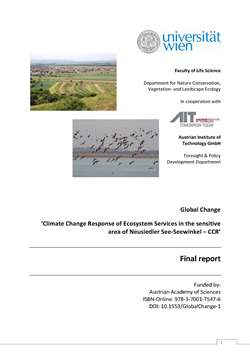
Global Change - “Climate Change Response of Ecosystem Services in the sensitive area of Neusiedler See-Seewinkel – CCR” - Final Report, pp. 1-78, 2013/10/15

Based on recent worldwide assessments, climate change is considered as a major threat to biodiversity together with habitat change, invasive alien species, overexploitation and pollution. Evidence for changes in ecosystems related to climate have been documented for the high European Alps, for the spreading of invasive species, for threats on plant diversity in Europe or for important ecosystems services such as water availability and quality and agricultural productivity.The concept of ecosystem functions, goods and services (MEA, 2005) has experienced increasing attention in the last years as it integrates major ecological processes and communicates their importance to society. Highlighting these values has been done in the BIOSERV-project, where ecosystem functions and services are identified for the region of Neusiedler-See, their potential and their current status. But with a changing climate, basic preconditions of the landscape will alter and hence, ‘potential’ as well as the ‘recent’ ecosystem functions are likely to change. These changes will have a big impact on the regions’ development, as the natural and economical values are highly interlinked in the area of the Seewinkel due to the special biodiversity situation and nature related tourism.Based on the consistent description of ecosystem functions and services as a precondition, we are able to focus on valuable assessment of climate change impacts in 2100, which in turn might be the basis for land use adaptation in the future. If we knew the main climate drivers of related ecosystem functions, we would be able to assess in which direction they are likely to change in the future, and what impact this would have for the regional development. This would enable the formulation of tailor-suited adaptation and mitigation measures for the region.